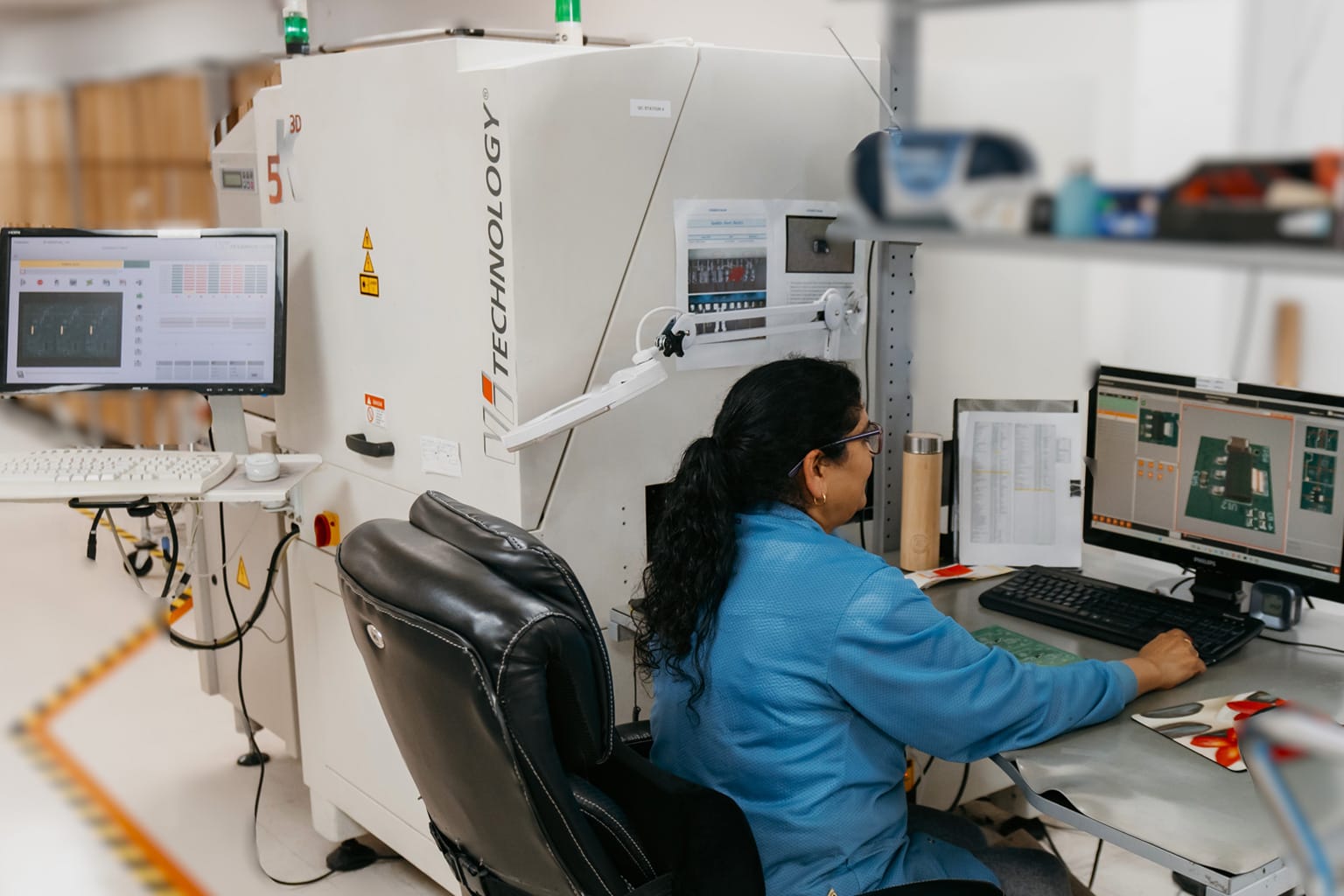“We need these boards in 8 weeks.”
“Best we can do is 14.”
If this conversation sounds familiar, you’re not alone. Many companies struggle with electronics manufacturing lead times that don’t align with their business needs. Whether you’re trying to meet a customer commitment, launch a new product, or fulfill an urgent order, manufacturing timelines directly impact your ability to compete and grow.
The question isn’t just why electronics manufacturing takes time. The question is: is your current manufacturing partner operating as efficiently as they could, and are there better options available?
This guide helps you understand what drives manufacturing timelines, how to identify whether your current partner’s lead times are reasonable, and what more responsive electronics manufacturing looks like.
TL;DR
- Component procurement drives 40-60% of electronics manufacturing lead times—the biggest factor most buyers overlook.
- Inefficient operations (poor planning, vendor coordination delays, communication bottlenecks) can add 4-8 weeks unnecessarily.
- Integrated capabilities (electronics + enclosures under one roof) eliminate 2-4 weeks of coordination time.
- Ask manufacturers to break down timelines by phase—transparent partners can explain where time is actually spent.
- Proactive component verification during quoting prevents timeline surprises after you’ve committed.
What Drives Electronics Manufacturing Lead Times
When manufacturers quote extended timelines, sometimes there are legitimate reasons. Other times, the timeline reflects how efficiently (or inefficiently) they operate.
When Extended Lead Times Make Sense
Some projects genuinely require longer timelines. Specialized components with 20-week lead times from manufacturers, extensive certification testing, complex first-time builds, or custom tooling requirements legitimately add time.
The key is understanding whether your timeline is driven by true project requirements or by your manufacturer’s processes and capabilities.
Common Factors That Can Extend Timelines
Several operational factors can add unnecessary time to projects:
→ Reactive component planning. Some manufacturers check component availability after receiving your order rather than during the quoting phase. This can add weeks to your timeline if long-lead parts are discovered late in the process.
Additionally, a component may have been available during the quoting stage, but by the time the quote is accepted and a purchase order is submitted (possibly weeks later) the part may no longer be in stock. Lead times can extend much further than expected, or the part may become high-demand, driving prices up substantially.
If a contract manufacturer needs to source from a broker due to unavailability, costs can increase significantly, causing challenges and frustration for both parties. The market for parts is in constant flux for availability and pricing.
→ Production scheduling challenges. Projects that sit in queues waiting for production slots rather than moving through efficient, well-planned schedules can experience delays that have nothing to do with the actual manufacturing time required.
→ Coordination complexity. When manufacturers outsource enclosures, cable assemblies, or other components to external vendors, every handoff adds coordination time and potential delays.
→ Limited communication flow. Projects that stall waiting for internal approvals, engineering answers, or quality sign-offs often reflect communication bottlenecks rather than real production requirements.
The difference between efficient and inefficient operations often shows up in the timeline—same project, dramatically different delivery dates depending on how the manufacturer operates.
Evaluating Your Current Manufacturing Partner’s Performance
Not sure if your current electronics manufacturing partner is operating efficiently? Here are questions worth considering:
1. Can they explain the timeline clearly?
Ask your manufacturer to break down their quoted lead time: component procurement duration, assembly setup time, production time, testing requirements, and any integration work.
Manufacturers who understand their processes can provide this breakdown. If explanations are vague or the timeline feels like a standard template regardless of project specifics, it’s worth asking more questions.
2. Do timelines vary based on project requirements?
Does your manufacturer quote similar timelines whether you’re building 50 units or 500? Whether components are readily available or require sourcing?
Realistic timelines should reflect actual project variables. Straightforward builds with available components typically complete faster than complex first-time builds requiring specialized parts.
3. How’s their communication?
Do you receive proactive updates about your project status, or do you need to reach out for information? Are you notified immediately when something affects your timeline, or do you discover delays when asking about delivery?
EMS project communication quality directly impacts project timelines. Waiting days for answers or approvals adds up quickly—and the responsibility goes both ways.
Strong manufacturing partnerships require responsive communication from both parties. When customers delay responses to technical questions or approval requests, projects get pushed back regardless of production efficiency. A question that sits unanswered for a week can turn a routine project into a rush job, increasing costs and creating scheduling conflicts.
The best manufacturing relationships are built on mutual responsiveness. Your EMS partner should provide proactive updates and quick answers. You should prioritize timely responses to their requests for approvals and clarifications. When both parties treat communication as urgent, projects stay on schedule.
4. Can they accommodate changing needs?
Business needs change. Sometimes you genuinely need faster turnaround on a project. If your manufacturer’s response is always “that’s impossible” or requires significant premium pricing for modest schedule adjustments, it may indicate limited flexibility in their operations.
Manufacturers with efficient processes typically have some capacity to accommodate urgent requests when needed. Is your EMS partner prepared to scale?
What Makes Electronics Manufacturing More Efficient
If you’re looking for manufacturing partners who deliver on competitive timelines, certain capabilities and practices make a measurable difference:
✓ Integrated Manufacturing Capabilities
One of the biggest opportunities to reduce lead times is eliminating vendor handoffs. When your electronics assembly and custom enclosures are handled by separate companies, coordination time adds up significantly.
Consider what happens with multiple vendors: Electronics complete, then ship to enclosure manufacturer. Wait for enclosures to fabricate and finish. Coordinate delivery to the integration facility. Manage schedules across three different companies, each with their own timelines and priorities.
Compare that to integrated manufacturing: electronics assembly and enclosure fabrication progress simultaneously under one roof. Integration begins as soon as both are ready. One point of contact manages the entire project.
At IMS, this integrated approach consistently reduces box build timelines by 2-4 weeks compared to coordinating separate vendors, simply by eliminating shipping time and coordination delays. The time savings come from efficiency, not from rushing individual processes.
✓ Proactive Component Management
Efficient manufacturers verify component availability during the quoting phase, providing realistic timelines based on real-time parts availability. They maintain relationships with multiple distributors and can often suggest alternates when first-choice components have extended lead times.
This proactive approach prevents timeline surprises. You know about potential component challenges before committing to a delivery date, not after.
✓ Streamlined Production Processes
Well-organized manufacturers move projects through production efficiently:
Clear scheduling keeps projects moving rather than sitting in queues. Parallel processing runs multiple phases simultaneously when possible. Quality checks throughout the process catch issues early rather than at final inspection. Efficient communication protocols ensure quick decisions without projects waiting for approvals.
These operational practices are what separate a 6-week build from a 10-week build for similar projects.
✓ Transparent Scheduling
There’s a difference between realistic timelines and unnecessarily padded schedules. Good manufacturers provide honest timelines based on actual requirements—and they can explain where time is spent.
When you genuinely need faster delivery, they can identify which timeline elements are flexible and which are fixed, helping you understand your options.
✓ Geographic Accessibility
Working with a manufacturer close to your time zone, like IMS in Calgary, offers practical advantages. Questions get answered quickly during your business hours. Facility visits are straightforward. Rush deliveries don’t require international shipping or customs clearance.
These advantages add up to faster communication and quicker resolution of any issues that arise.
Realistic Timeline Expectations
Understanding typical timelines for different project types helps you evaluate whether your manufacturer’s quotes are reasonable:
⚙️ Quick-Turn Prototypes
With readily available components and expedited processing: 2-3 weeks from order to delivery is typical. Rush jobs with premium pricing can sometimes deliver in 1 week if components are in stock and immediate scheduling is available.
⚙️ Low to Medium Volume Production (100-1000 units)
For established products with available components: 4-6 weeks is reasonable. First-time builds or projects with specialized components: 8-12 weeks accounts for component procurement, first article inspection, and production ramp-up.
⚙️ Medium to High Volume (1000+ units)
Established products with proven processes: 6-10 weeks is typical. First production runs with new components or custom tooling: 10-16 weeks reflects additional setup and verification requirements.
What Legitimately Adds Time
Certain requirements predictably extend timelines:
- Custom components or tooling add 4-8 weeks depending on complexity.
- Specialized testing requirements add 1-2 weeks for custom fixtures and protocols.
- Complex box build assembly adds 2-4 weeks for integration and system testing.
- Certification testing adds 2-6 weeks depending on regulatory requirements.
- These aren’t inefficiencies—they’re necessary phases for specialized builds.
When to Consider Changing Electronics Manufacturing Partners
Changing electronics manufacturing partners requires thought and effort. There’s always a learning curve as new partners get familiar with your products.
However, if manufacturing timelines consistently create business challenges, exploring alternatives makes sense. Consider whether:
⚠️ Your manufacturer struggles to meet timeline requirements even for straightforward builds with available components.
⚠️ Communication is inconsistent, and you frequently need to chase status updates.
⚠️ Timeline breakdowns are vague or don’t reflect project variables.
⚠️ You’re coordinating multiple vendors for what could potentially be handled as an integrated build.
⚠️ Your business needs require a faster response than your current partner can provide.
What a Better Manufacturing Partnership Looks Like
If you’re evaluating new electronics manufacturing services, look for partners who demonstrate:
✅ Transparent timeline planning with clear breakdowns showing where time is actually spent.
✅ Proactive component verification so you know about availability issues during quoting, not after committing.
✅ Integrated capabilities that can eliminate vendor coordination for electronics, enclosures, and assembly when applicable.
✅ Realistic but competitive schedules based on actual requirements rather than standard templates.
✅ Consistent communication with regular updates and immediate notification of any timeline changes.
✅ Flexibility for urgent needs with reasonable options to expedite critical projects when necessary.
✅ Local accessibility for facility visits, collaboration, and faster communication.
IMS’s Approach to Timeline Management
At IMS, we take pride in providing realistic timelines and delivering on our commitments. We check component availability before quoting so your timeline reflects reality from day one. Our integrated sheet metal fabrication and electronics assembly eliminates coordination delays for box build projects.
We provide clear timeline breakdowns and communicate proactively if anything changes. Our design for manufacturability review catches potential issues early, before they impact your schedule.
We don’t overpromise timelines we can’t meet. Instead, we provide honest schedules based on your requirements, then work efficiently to deliver on those commitments.
Making Informed Decisions About Manufacturing Partners
Understanding what drives electronics manufacturing lead times helps you evaluate whether your current partner’s performance is reasonable and whether alternative EMS options might better serve your needs.
Component availability, integrated capabilities, production efficiency, and communication quality all significantly impact timelines. When these elements work well, manufacturing proceeds smoothly. When they don’t, projects experience unnecessary delays.
If your current manufacturing timelines create business challenges, it’s worth exploring whether more efficient options exist.
Ready to discuss your timeline requirements?
Our team can provide realistic timeline estimates based on your specific needs and show you how our integrated approach delivers efficient production schedules.
Contact IMS to discuss your project and learn more about our capabilities. Let’s talk about what responsive electronics manufacturing looks like and whether it might better serve your business needs.




